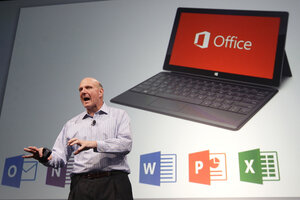New Microsoft Office designed for fingers, styluses, keyboards, and mice
Microsoft preps for "the most ambitious release of Office we’ve ever done," says CEO. But will it be a jack-of-all-trades, master of none?

Microsoft CEO Steve Ballmer speaks at a Microsoft event in San Francisco, Monday, July 16, 2012. Microsoft unveiled a new version of its widely used, lucrative suite of word processing, spreadsheet and email programs Monday, one designed specifically with tablet computers and Internet-based storage in mind.
Jeff Chiu/AP
SAN FRANCISCO
Microsoft on Monday unveiled a new version of its Office software suite designed with its upcoming Windows 8 operating system in mind.
The updated Office applications have been rejiggered to work more easily with touch-screen devices. One of the prime features of Windows 8 is its Metro interface, which was designed for smartphones and tablets.
“This is the most ambitious release of Office we’ve ever done,” CEO Steve Ballmer announced at a news event here.
The new version of Office is designed to be extraordinarily flexible, Ballmer said. Users will be able to run it on touch-screen tablets and PCs. They will be able to interact with it using their fingers, styluses, keyboards or mice. And they can purchase it as packaged software or subscribe to it as a service.
Microsoft has only overhauled two of the applications — the OneNote note-taking program and the Lync collaboration software — so that they will work under the Metro interface. All the other applications can be used only in Windows’ traditional desktop interface.
But the company has added features to all of the Office applications. Word, for example, will get a new “reading” mode that mimics an e-reader. Users will be able to turn pages and add notes to documents much like they would using Amazon’s Kindle app.
Excel’s upgrade will allow users to see a quick preview of charts and tables without having to go through the steps of creating each one first.
The entire suite of Office software is designed to embrace some of the latest technology trends. By default, the new Office will save users’ documents and settings on Microsoft’s servers. That will allow users to access all their documents and settings regardless of what Office compatible device they are using, from a Windows PC to a Windows phone.
Social networking also will be highlighted. Users will be able to share documents on Facebook or LinkedIn and instantly connect with contacts on Skype while within the Outlook email program. And Microsoft is turning its SharePoint service into something of its own social network, allowing users to post messages, comment on others’ messages and share links or videos.
The new version of Office includes plenty of new and promising features, said Mike Silver, an analyst at Gartner, a technology research firm. But he added that it may struggle to catch on.
Microsoft is planning to end its support for Windows XP, the still widely used 10-year-old version of the operating system, in less than two years, noted Silver. Organizations that are still running XP are largely focused on moving their computers and users off of it, rather than worrying about upgrading to the latest version of Office, he said.
Spending time to evaluate the new version of the software suite “is time that a lot of organizations just don’t have,” said Silver. Office’s new features “may encourage them to upgrade, but it may not be right away,” he added.
Microsoft declined to say when the new Office will be available or how much it will cost.
The new Office will come in multiple versions and will go by multiple brand names. For example, the online version will maintain its “Office 365” moniker, while the retail version will go by Office 2013. The version of Office that will run on computers using chips designed by ARM won’t include the Outlook email program that’s included in other versions of the software. But at the news conference Monday, company representatives repeatedly referred to the software suits simply as “Office.”
Silver said that all the different names could lead to consumer confusion. “Microsoft’s naming is a real mess at this point,” he said.
The company said it will release more details on the software this fall.
Office has become Microsoft’s cash cow, providing more than 30 percent of its sales and more than half of its revenue in its current fiscal year. But the new version of the suite comes as Microsoft’s products are beset by heightened competition.
The new version of Office may give upcoming Windows 8-based tablets a way to distinguish themselves in a market currently dominated by Apple’s iPad. Meanwhile, many of the new cloud-based features that will be in Office resemble those already offered in services such as Google Docs and Dropbox.
MICROSOFT’S NEW OFFICE SUITE:
Among the new features:
- Metro style: Two of the Office applications — OneNote and Lync — have been redesigned to work natively under the Metro interface that is the centerpiece of Windows 8. Other applications will continue to run under a version of Windows’ traditional desktop.
- No messy ink: Many of the applications allow users to annotate documents, take notes and underline changes using a stylus. Microsoft hopes these features will replace physical notepads and users hand-editing printed documents.
- In the cloud: Office documents and users’ settings are saved to Microsoft’s servers by default so that they can be accessed on multiple devices.
- Socially aware: Users can share documents on Facebook and LinkedIn. They can instantly connect to contacts on Skype from within Outlook. And the new version of SharePoint offers a news feed much like that found on most social networks.
- Reading and writing: Word gets a new “reading” mode that allows it to imitate an e-reader application.

